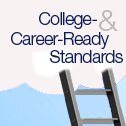In common-core states, nearly all math and language arts teachers are at least somewhat reliant on materials they’ve developed or selected themselves, according to a new nationally representative survey.
The RAND Corporation just released a series of surveys looking at how K-12 teachers understand and are implementing state standards, including what materials they’re using. The results focus on teachers in the 42 states that are using the Common Core State Standards or standards that were adapted from them. (RAND defines those as every state except Alaska, Indiana, Minnesota, Nebraska, Oklahoma, South Carolina, Texas, and Virginia.)
One survey, administered in June 2015, asked about 1,100 math and ELA teachers how often they used particular materials. Here’s how math teachers in common-core states—referred to as Standards Adapted from Common Core, or SACC, states—responded. (Note they were counted if they said they used the materials more than “never”).

As you see, elementary and secondary school math teachers are almost all using materials they developed or selected themselves. Just as many elementary teachers and nearly as many middle school teachers are using materials they got from their district.
The report also notes that teachers are using the materials they developed or selected fairly frequently: 82 percent of elementary math teachers and 91 percent of secondary math teachers reported using them at least once a week.

Notably, 44 percent of elementary math teachers and 30 percent of secondary teachers are using materials from EngageNY, the free online library created by New York state. Among elementary teachers, those free materials, developed by Eureka Math, were used more often than any of the commercial publishers listed. (Eureka Math is also listed separately below because the publisher Great Minds offers the curriculum on its own site, too, in addition to paid products.)
In a curriculum review last year by the nonprofit EdReports.org, Eureka Math outperformed all other K-8 materials for common-core alignment (though that review later faced some controversy).
English/Language Arts Materials
Here’s how things shook out for English/language arts teachers in common-core states:

Again, self-developed or self-selected materials were the most popular, and district materials were also quite well-used.
Here, the researchers also asked whether teachers were using “leveled readers,” or texts that are differentiated by students’ abilities rather than their grade level. In elementary school, nearly all teachers were using them at least somewhat. In fact, 59 percent of teachers reported using them daily or almost daily, the report says.
“These findings suggest that elementary teachers ask students to spend a substantial portion of their time on leveled readers written at students’ individual reading level, particularly if students are below their grade level in reading,” the report states. It also notes that while the common-core standards don’t prohibit the use of leveled readers (or mention them at all), the standards do emphasize the need to use texts that are on grade level. That is to say that the use of leveled readers isn’t particularly well-aligned with the common-core standards.
Google, Pinterest, TeachersPayTeachers
The researchers also looked in more detail at where teachers are finding materials online. In this case, Google came out on top. Pinterest and Teacherspayteachers were not far behind. Interestingly, the websites most frequently used by common-core teachers are not ones that offer common-core materials specifically—so teachers are either searching for common-core lessons within those sites or they’re using materials that may not necessarily be aligned to the standards.

The findings echo those of another recent study that found teachers are using homegrown materials and free online platforms to meet the common core.


